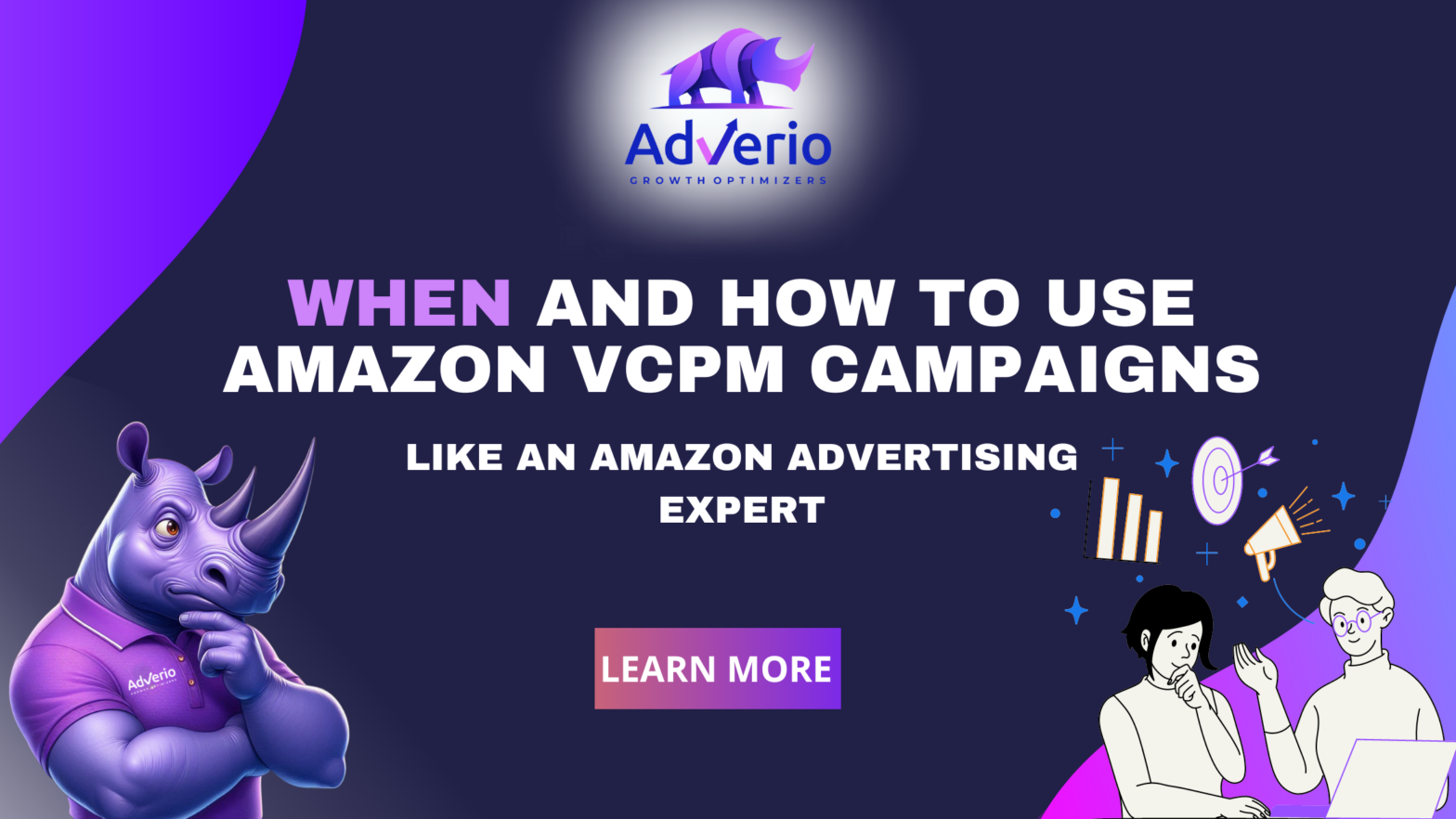Table of Contents
Amazon sellers aiming to expand their digital marketing reach and scale must leverage Amazon Sponsored Display ads.
Introduced in 2022 to the Amazon Sponsored Ads Suite, the viewable cost-per-mille (VCPM = cost per 1,000 viewable impressions) model was intended to transform how brands measure the ads’ impact on their target customers’ journey.
However, it seems to have caused more issues than solved, as we’ll discuss below the pros and cons of using VCPM for Amazon Sponsored Display ad tactics.
Understanding the nuances of VCPM can significantly influence how you can effectively measure your brand’s presence and the impact of the number of ads being served to your various audiences.
Dive into the mechanics of Amazon VCPM campaigns with this in-depth exploration. Here, you will learn the essence of VCPM, uncover how it operates, and discover effective strategies to capitalize on this model for substantial results. We’ll tackle the complexities of VCPM attribution and guide you through maintaining precise campaign performance assessments.
Additionally, get ready to absorb practical advice and best practices tailored for Amazon sellers eager to refine their VCPM, or non-VCPM, approach and achieve their marketing ambitions.
Understanding Amazon VCPM Campaigns
Amazon VCPM campaigns charge advertisers based on the number of viewable impressions their ads receive, rather than clicks. Amazon Ads adheres to the MRC definition for an ad view.
- At least 50% of the ad should have been in the customer’s viewport for at least 1 second for it to be registered as a viewed impression.
- For videos, at least 50% of the ad should have been in the customer’s viewport with 2 seconds playback completed.
The formula to compute vCPM (viewable Cost Per Thousand impressions) is as follows:
vCPM = Total Expenditure / ((Total Impressions * % Viewable) / 1000)
Here’s a step-by-step guide to using this formula
- Identify the total expenditure for your advertising campaign, which represents the complete amount spent on the advertisement initiatives.
- Calculate the total number of impressions made throughout the campaign.
- Assess the percentage of those impressions that are considered viewable, defined by at least 50% of the advertisement being visible on the screen for a minimum of one second.
- Apply the previously mentioned formula: divide the total expenditure by the number of viewable impressions, then multiply the quotient by 1,000 to find the vCPM.
Consider this scenario as an illustration
Suppose an ad campaign has an expenditure of $12,000 and achieves 200,000 impressions, with 70% of these impressions being viewable.
Here’s how the vCPM would be calculated:
- vCPM = $12,000 / ((200,000 * 70%) / 1000)
- vCPM = $12,000 / (140,000 / 1000)
- vCPM = $12,000 / 140
- vCPM = $85.71
In this case, the vCPM would amount to $85.71 per thousand viewable impressions.
It’s crucial to understand that various factors can influence this calculation. The type of ad, its format, and its placement play significant roles in viewability, hence impacting vCPM. For example, video ads typically command higher vCPMs than static display ads due to their enhanced engagement and greater likelihood of being viewed.
Additionally, positioning ads ‘above the fold’ usually results in better viewability compared to those placed ‘below the fold.’ Rich media ads, known for their dynamic and interactive elements, also tend to register higher viewability percentages compared to standard banner ads.
By taking these elements into account when calculating vCPM, advertisers can better evaluate their ad campaigns and fine-tune their strategies to maximize effectiveness and revenue.
It’s essential for Amazon sellers to understand the difference between VCPM and traditional cost-per-mille (CPM) pricing models. While CPM charges advertisers for every 1,000 ad impressions regardless of viewability, VCPM only charges for viewable impressions that meet the MRC and IAB guidelines . This means that with VCPM, you’re paying for ad placements that have a higher likelihood of being seen by potential customers.
When to Use Amazon VCPM Campaigns
VCPM campaigns are particularly effective for reaching shoppers at the top of the sales funnel. Consider using them when:
- Launching a new brand or product to generate buzz and anticipation
- Reinforcing brand identity and messaging to foster lasting customer awareness
- Targeting new-to-brand shoppers on and off Amazon
- Promoting seasonal offers, sales, or limited-time deals
- Entering new markets or regions to introduce your brand to fresh audiences
While VCPM campaigns alone may not drive immediate sales, integrating them with other ad campaigns can create a well-rounded strategy that caters to every stage of the customer journey.
The Pitfalls of VCPM Attribution
One of the main challenges with VCPM campaigns is their potential to distort your metrics and obscure the true performance of your other ad campaigns. This is due to Amazon’s last-touch attribution model, which gives full credit for a sale to the last ad a shopper viewed or clicked before making a purchase.
VCPM campaigns can
Obscure organic purchases by flashing attributing otherwise organic sales into ad-attributed sales
Paper over successful ad campaigns by taking credit for sales driven by other campaigns that brought the shopper to your product page in the first place
To illustrate this point, imagine a shopper who discovers your product through a Sponsored Product ad, clicks on it, and lands on your product detail page.
Just before they make a purchase, a VCPM ad for the same product appears on their screen. Due to Amazon’s last-touch attribution model, the VCPM ad would receive full credit for the sale, even though the Sponsored Product ad played a more crucial role in the customer’s journey that landed them on your product page(s).
Strategies for Optimizing VCPM Campaigns
To make the most of your VCPM campaigns while minimizing attribution issues, consider the following strategies:
1. Run A/B testing
Compare different attribution models of identical ads to determine if the VCPM actually leads to more incremental sales than the CPC version. Continuously refine your approach based on data-driven insights.
2. Change your attribution model
Consider using Amazon Marketing Cloud (AMC) to move away from the last-touch attribution model and select a more holistic approach, such as first-touch or equal-weight attribution. This will give you a clearer picture of how your VCPM campaigns contribute to your overall advertising success.
3. Set clear campaign goals
Define specific, measurable goals for your VCPM campaigns, such as increasing brand awareness, driving traffic to your product pages, or boosting new product sales. Align your targeting, ad creative, and bid strategy with these goals to ensure your campaigns are focused and effective.
4. Monitor and adjust your bids
Keep a close eye on your VCPM campaign performance and adjust your bids accordingly. If your ads are receiving a high number of viewable impressions but not driving the desired results, consider increasing your bids to win more ad auctions and reach a larger audience.
Best Practices for Amazon Sellers
In addition to the strategies mentioned above, here are some best practices for Amazon sellers looking to optimize their Amazon VCPM campaigns:
1. Create compelling ad creative
Design eye-catching, informative ad creative that showcases your product’s unique value proposition and aligns with your brand identity. Use high-quality images, videos, clear text, and a strong yet compliant call-to-action to capture shoppers’ attention and encourage engagement.
2. Optimize your product pages
Optimize your product pages by incorporating relevant keywords, crafting detailed descriptions, showcasing high-quality images and videos, gathering substantial positive customer reviews, and setting competitive prices based on market insights. This will improve your ad relevance and help convert the traffic generated by your VCPM campaigns.
3. Segment your campaigns
Organize your VCPM campaigns into distinct campaigns based on factors such as product category, target audience, or campaign goal. This allows you to tailor your ad creative, targeting, and bid strategy to each group for better performance.
4. Allocate budget wisely
Determine the appropriate budget for your VCPM campaigns based on your overall advertising strategy and goals. While VCPM campaigns can be effective for building brand awareness, be sure to allocate sufficient budget to other campaign types that drive more direct sales.
5. Stay up-to-date with Amazon advertising updates
Amazon’s advertising landscape is constantly evolving, with new features, tools, and best practices emerging regularly. Stay informed about the latest updates and adapt your strategy accordingly to stay ahead of the competition.
Join our Adverio newsletter to get ahead of the Amazon brands in your niche and implement the latest ad strategies – before anyone else does.
To VCPM or Not VCPM, that’s the question
Amazon VCPM Campaigns can be a powerful tool for building brand awareness and reaching customers at the top of the sales funnel. However, it’s essential to understand their potential impact on your metrics and attribution. By implementing smart optimization strategies, adopting a more holistic attribution model, and following best practices for Amazon sellers, you can test leveraging VCPM campaigns to drive incremental results while aiming to accurately measuring their performance.
As an Amazon seller, investing time and resources into mastering VCPM campaigns can give you a significant competitive advantage. By understanding the intricacies of this ad type, optimizing your campaigns for maximum impact, and avoiding common attribution pitfalls, you can build a strong brand presence, reach new customers, and ultimately drive more sales on the platform.
Remember, the key to successful Amazon advertising is a well-rounded strategy that caters to every stage of the customer journey. By combining VCPM campaigns with other ad types, continuously refining your approach based on data-driven insights, and staying agile in the face of industry changes, you can maximize your ad performance and achieve your business goals on Amazon.
Frequently Asked Questions (FAQs) Related to Amazon VCPM Campaigns
1. What is Amazon VCPM?
VCPM (Viewable Cost-Per-Mille) is an Amazon ad model that charges based on viewable impressions, not clicks.
2. When should I use VCPM campaigns?
VCPM campaigns are effective for building brand awareness, reaching new customers, and promoting seasonal/limited-time offers.
3. How do I measure VCPM performance?
Carefully track VCPM metrics and consider using Amazon Marketing Cloud for a more holistic attribution model.
4. What are the challenges with VCPM?
VCPM can distort metrics by over-crediting sales, obscuring the impact of other ad campaigns.
5. What are best practices for VCPM?
Create compelling ads, optimize product pages, segment campaigns, allocate budgets wisely, and stay updated on Amazon changes.





























